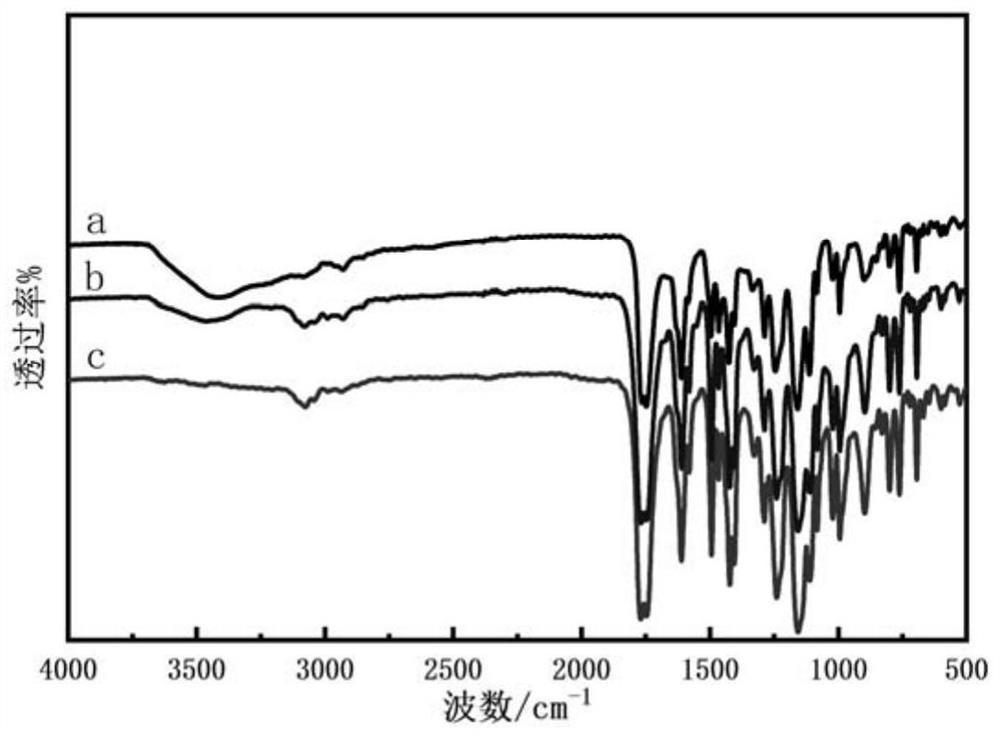Preparation method of a composite fluorescent hydrogel and its application in the detection of iron ions in water
A composite fluorescence and hydrogel technology, applied in the direction of fluorescence/phosphorescence, general water supply saving, chemical instruments and methods, etc., can solve the problems of insoluble in water, inconvenient to carry, poor stability of fluorescent probes, etc., and achieve low price , easy operation, excellent mechanical strength effect
- Summary
- Abstract
- Description
- Claims
- Application Information
AI Technical Summary
Problems solved by technology
Method used
Image
Examples
Embodiment 1
[0032] A method for preparing P(BAcF-AM) / PEG composite fluorescent hydrogel, comprising the steps of:
[0033] (1) Preparation of BAcF:
[0034] Dissolve 4 g (0.012 mmol) of spironolactone-type fluorescein (CAS number: 2321-07-5) in dichloromethane, blow nitrogen gas, add triethylamine, and slowly add 1 mL dropwise to fluorescein under ice-bath conditions (0.012mmol) acryloyl chloride (control drop time is 30min) after stirring at room temperature for 12 hours, use a rotary evaporator to remove dichloromethane, then wash with acetone to filter triethylamine hydrochloride, and finally wash with water repeatedly After settling and suction filtration, the filter residue was freeze-dried for 48 hours to obtain the product acryloyloxyfluorescein (BAcF). Characterization of BAcF by infrared spectroscopic testing, such as figure 1 As shown by the curve a in the middle;
[0035] (2) Preparation of P(BAcF-AM) / PEG composite fluorescent hydrogel:
[0036] (a) Prepare an acrylamide so...
Embodiment 2
[0044] A preparation method of P(BAcF-AM) / PEG composite fluorescent hydrogel is as follows:
[0045] (1) Preparation of BAcF:
[0046] The amount of acryloyl chloride added was 2mL (the molar ratio of spironolactone fluorescein and acryloyl chloride was 1:2), and the other steps were the same as the preparation method in step (1) of Example 1, and the BAcF was characterized by infrared spectroscopy, Such as figure 1 As shown in the middle b curve;
[0047] (2) Preparation of P(BAcF-AM) / PEG composite fluorescent hydrogel:
[0048] (a) Prepare an acrylamide solution with a monomer concentration of 5 mol / L, weigh and add 0.2% by mole of the cross-linking agent BIS, 0.5% by mole of the initiator APS and 5% by weight of PEG-6000, the above solution Stir magnetically at room temperature for 5 minutes, weigh 0.1% by weight BAcF and dissolve it in 1mL DMSO evenly, mix the above two solutions evenly, transfer the whole into a three-necked flask, and pass nitrogen gas for 5 minutes; ...
Embodiment 3
[0054] A preparation method of P(BAcF-AM) / PEG composite fluorescent hydrogel is as follows:
[0055] (1) Preparation of BAcF:
[0056] The amount of acryloyl chloride added is 4mL (the molar ratio of spironolactone fluorescein and acryloyl chloride is 1:4), the others are the same as the preparation method in step (1) of Example 1, and the BAcF is characterized by infrared spectroscopy, such as figure 1 As shown in the curve of c;
[0057] (2) Preparation of P(BAcF-AM) / PEG composite fluorescent hydrogel:
[0058] (a) Prepare an acrylamide solution with a monomer concentration of 7mol / L, weigh and add 0.1% by mole of crosslinking agent BIS, 1% by mole of initiator APS and 8% by weight of PEG-6000, the above solution Stir magnetically at room temperature for 5 minutes, weigh 0.1% by weight BAcF and dissolve it in 1mL DMSO evenly, mix the above two solutions, transfer the whole into a three-necked flask, and pass nitrogen gas for 5 minutes;
[0059] (b) Add 46 μL TEMED to the ...
PUM
| Property | Measurement | Unit |
|---|---|---|
| tensile strength at break | aaaaa | aaaaa |
| tensile strength at break | aaaaa | aaaaa |
| tensile strength at break | aaaaa | aaaaa |
Abstract
Description
Claims
Application Information
 Login to View More
Login to View More - R&D
- Intellectual Property
- Life Sciences
- Materials
- Tech Scout
- Unparalleled Data Quality
- Higher Quality Content
- 60% Fewer Hallucinations
Browse by: Latest US Patents, China's latest patents, Technical Efficacy Thesaurus, Application Domain, Technology Topic, Popular Technical Reports.
© 2025 PatSnap. All rights reserved.Legal|Privacy policy|Modern Slavery Act Transparency Statement|Sitemap|About US| Contact US: help@patsnap.com



